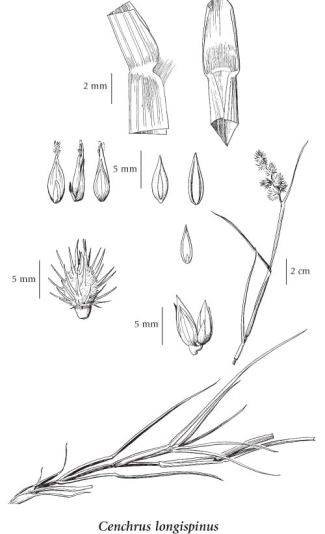Cenchrus longispinus (Hack.) Fernald
burgrass (field sandbur; mat sandbur)
Poaceae (Grass family)
Introduction to Vascular Plants
burgrass (field sandbur; mat sandbur)
Poaceae (Grass family)
Introduction to Vascular Plants
Species Information
General:
Annual, prostrate, often widely matted grass from fibrous roots; stems semi-solid, 60-150 cm long.
Leaves:
Sheaths open, smooth, keeled, the collars constricted, sometimes hairy; blades 2-6 mm wide, flat or folded; ligules 1-1.5 mm long, the fringes 2 to 4 times as long as the basal membranes.
Flowers:
Inflorescence of short, crowded, spikelike racemes; the spikelets 2-flowered, 5-6 mm long, tightly enclosed within and deciduous with spiny burs formed by the basal union of numerous sterile branches, 1, 2, or more per bur, the burs 5 to 10, 4-6 mm wide when pressed, finely hairy, the spines numerous, flattened, more or less fused at the base; lower glumes considerably reduced, narrow, 1 (3)-nerved, the upper ones usually shorter than the lower lemmas, pointed, 3-nerved; lower flowers sterile but usually with lemmas and paleas, the upper flowers perfect with lemmas firm; lodicules absent.
Illustration

If more than one illustration is available for a species (e.g., separate illustrations were provided for two subspecies) then links to the separate images will be provided below. Note that individual subspecies or varietal illustrations are not always available.
Illustration Source: The Illustrated Flora of British Columbia
Habitat and Range
Moist to dry sandy shores and disturbed sites in the lowland and steppe zones; rare in SW BC (New Westminster), infrequent in extreme SC BC; introduced from the S U.S.Status Information
| Origin Status | Provincial Status | BC List (Red Blue List) | COSEWIC |
|---|---|---|---|
| Exotic | SNA (2019) | Exotic | Not Listed |
BC Ministry of Environment: BC Species and Ecosystems Explorer.
Synonyms
Synonyms and Alternate Names:
Cenchrus carolinianus Walter